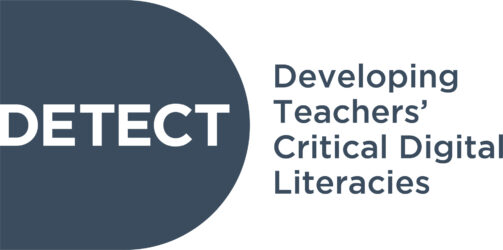The term “data” is becoming probably a sort of buzzword. What do we
mean with “data”? How do you feel about the word “data”? And why
should we need to be “data literate”?
You might also come across “Big Data”, “Open Data” ,”Data Science”,
Datafication” and “Datafied” as words. And overall, some of this
words have positive connotations and others, very negative
implications for our lives. Clearly, we deal with a problem with many
facets. As educators, we need to explore them to understand which is
the message we want to cater to our students.
Overall, “data” refers to the digital data collected through our
interaction with digital spaces, apps, and smart technologies,
including the Internet of Things. And while this data might be part of
open, public knowledge and could be mined to produce new human
activities, like Artificial Intelligence, there are many connected
problems. Not only the form into which data are collected, without the
consent of the people from which such data are extracted, could be a
concern. Also, the surveillance, the end users’ manipulation through
nudges and recommendations, or the misrepresentation of collectives
are emerging issues connected to all the practices around data. As a
result, there is increasing concern in developing data literacy.
Data Literacy has received great attention over the last few years in
relation to school practices and has been identified as one of the
dimensions of the DETECT Critical Digital LIteracies framework.
Although the issue of Data Protection is usually addressed by relevant
policies at institutional level (mainly in relation to GDPR compliance)
less attention has been paid to raising educators as well as students’
awareness regarding the various aspects and sub-dimensions of data
literacy. Within the DETECT project the aim is to develop educators’
understandings of the multifacet issue of data literacy and also
support them with enhancing their students’ practices in relation to
data protection
This interactive, self-paced learning resource introduces three
perspectives on data literacy:
– Data Protection and Safety
– Open Data to develop critical citizens’ data literacy –
– Data Justice: exploring the dark side of data
The resource can be used either in educators’ workshops or
continuing training. Also it could be a good source of learning for
initial teachers’ education.
Moreover, the teachers could adopt some of the concepts for selfpaced
learning aimed at design lesson plans on data literacy for
secondary school learners.
- Data Literacy, Data Protection and Safety, Open Data, Data Justice
- text | image
- Website with integrated resources: video, documents, interactive graphics
- GoogleSites, mp4, Mentimeter presentation
- Juliana Raffaghelli and Anastasia Gouseti
- Attribution – Only noncommercial uses – Share Alike (CC BY-NC-SA)
- https://sites.google.com/view/lttadataliteracy/home
- 1
- -
- Ideally, this resource should be introduced prior to a workshop activity. The resource is aimed at working with educators in three phases: 1- Prior reading and exploring the teachers’ own approach to data 2- Workshop with discussion 3- Design for Learning
- 1) To understand how data shapes our contemporary society, with relevant impacts on the educational context 2) To explore at least one of the several three perspectives on the problem of data in the society 3) To be able of designing for learning to support the development of data literacy in one of the three areas: data protection and safety; open data for critical citizenship; data justice.
- Modeling (e.g. thinking aloud technique based on teacher shaping conceptual reasoning), Discussion (e.g. students engaged in an open debate on a certain topic), Project work (e.g., students working in small group to develop a project), Self-paced learning based on video and interactive resources
- Min 90 minutes Max 240 minutes
- Self-paced learning: 90 minutes per 3 learning pathways at learners’ will. Workshop: 240 mins (90 self-paced, 30 presentation/orientation, 60 groupwork, 60 plenary session) The activity starts with two introductory videos (15 mins) In the two videos, the concept of "data cultures" is introduced to reflect about the complexity of data in our societies. Dat cultures stands for a contextualised use of data, within education institutions, that allow the users to learn and to embrace balanced perspectives on data, to learn to live well with the above mentioned technological change. Therefore, the embedded idea is that data literacy requires not only technical, but also aesthetical, political and ethical approaches to understand and use data. The videos are followed by a brief readings, that prepare the participants’ choice of an activity of the three pathways offered. The learners are invited hence at select one of the pathways [ASYNCHRONOUS ACTIVITY, 90 minutes] We introduce three perspectives about data, as a complex problem, and invite you to select one to start learning. § Data Protection and Safety - Combining a reactive data "mindset" and the need to protect personal data, we'll explore the role of educators in supporting their own and ther students' awareness, security and safety while going through digital spaces. § Open Data to develop critical citizens' data literacy - Combining a proactive data "mindset" and the possibility to access to public, open data, we'll explore how open data can be used for civic education, also cultivating data visualization and data storytelling. § Data Justice: exploring the dark side of data - Combining a reactive data "mindset" and the need to access and generate fair public, open data, we'll explore the role of educators in promoting data justice. Therefore, there is a moment to share, discuss and prepare for designing a lesson plan as final outcome [ASYNCHRONOUS ACTIVITY, 40 min interactions with resources] + [ SYNCHRONOUS ACTIVITY, 90 min workgroup and 60 min plenary session] The participants engage with resources connected to the perspective chosen, and will debate around possible and future pedagogical practices.
- Self-evaluation (e.g. students self-evaluate their products), Peer evaluation (e.g. mutual evaluation among students), Course evaluation by the participants.

